Air Force films stunning clip INSIDE Hurricane Lee, as frightening graphic shows how it quickly became Cat-5, 165MPH storm that could smash east coast
Stunning images have revealed the thundering eye of Hurricane Lee as it barrels towards the east coast, threatening to leave a trail of chaos in its wake after escalating from a Category 1 to a Category 5 hurricane overnight.
The Air Force’s ‘Hurricane Hunters’, a weather reconnaissance squadron, delivered brutal lightning strikes that lit up the twister in a breathtaking way. social media post on Friday.
Hurricane Lee has been barreling across the Atlantic Ocean for days as it gathers steam, but forecasters are struggling to determine its path and the hurricane is not expected to make landfall until late next week.
As the East Coast braces for an impact, New York City and Boston got an early taste of the potential devastation when the hurricane’s currents produced severe storms Friday evening.
The eye of Hurricane Lee was seen in breathtaking footage captured by the Air Force’s ‘Hurricane Hunters’, a weather reconnaissance squadron
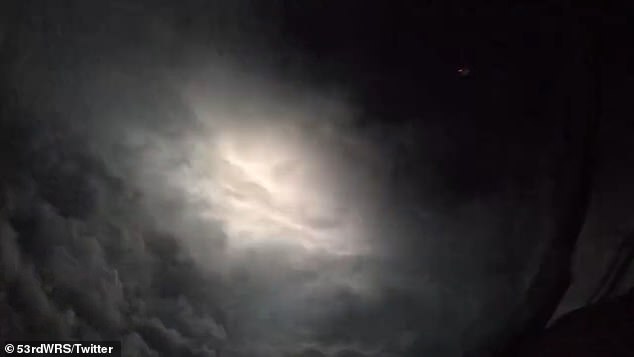
Relentless lightning strikes illuminated the destroyer, which was hurtling into the Atlantic Ocean on Friday evening, some 700 kilometers off the east coast.
Hurricane Lee was registered as a Category 1 hurricane on Wednesday after forming near the Leeward Islands in the Caribbean.
Forecasters quickly warned it had devastating potential, and shocking satellite projections showed it gaining speed and strength on Thursday, reaching speeds of more than 160 mph.
Earlier in the day, the twister registered speeds of about 80 miles per hour. After the storm spiraled across the Atlantic Ocean, waves reached more than 55 feet (17.5 meters) near the center, the National Hurricane Center found.
One reason for the escalation is the unusually warm water over the Atlantic Ocean, which has registered nearly 86 degrees Fahrenheit in its path, which meteorologists say is more similar to temperatures in the Gulf of Mexico than the Atlantic Ocean.
As of Friday evening, Lee remained well off the U.S. coastline and was about 450 miles (700 kilometers) east of the Leeward Islands, moving northwest at 13 mph (21 km/h), according to the New York Times.
As it spirals well to the southeast of its potential landfall, meteorologist and hurricane expert Michael Lowry warned that it has features that could cause significant damage.
He said on X (formerly Twitter) that ‘Lee is the furthest southeast we have ever observed a Category 5 hurricane in the Atlantic Ocean since records began 172 years ago.’
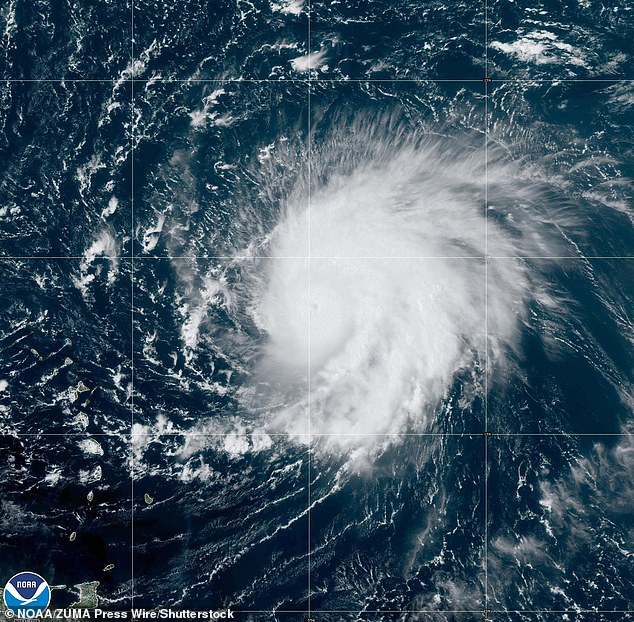
Hurricane Lee escalated from a Category 1 to a Category 5 hurricane on Thursday night, sparking fears it could tear apart the East Coast
While the sheer proximity to any landmass has limited destruction so far, the East Coast of the United States could see dangerous surfing conditions as early as Sunday, according to the National Hurricane Center.
“There are likely to be some fluctuations in intensity over the next few days, but Lee is expected to remain a strong major hurricane through early next week,” the NHC said Friday.
Meteorologists have apparently gone back and forth on whether the hurricane will hit the East Coast or possibly turn around. On Wednesday, the NHC warned: “Most intensity models are very aggressive, pushing Lee to major hurricane status by the weekend.”
In a forecast discussion on Friday, the center pushed back on this forecast, conceding that “it is far too early to know what level of impact, if any, Lee could have along the US East Coast, Atlantic Canada or Bermuda late next year.” week’.
The forecaster added that this could be because “the hurricane is expected to slow significantly over the southwestern Atlantic Ocean.”
Spaghetti models of Hurricane Lee’s path — maps that show computer simulations of where the storm’s center might be in several days, given a range of variables — show Lee turning northeast and heading toward the East Coast.
However, similar reassuring models have tragically backfired in the past. In 2017, meteorologists predicted that Hurricane Irma would turn toward the ocean before ravaging Florida’s Gulf Coast and causing at least 92 deaths.
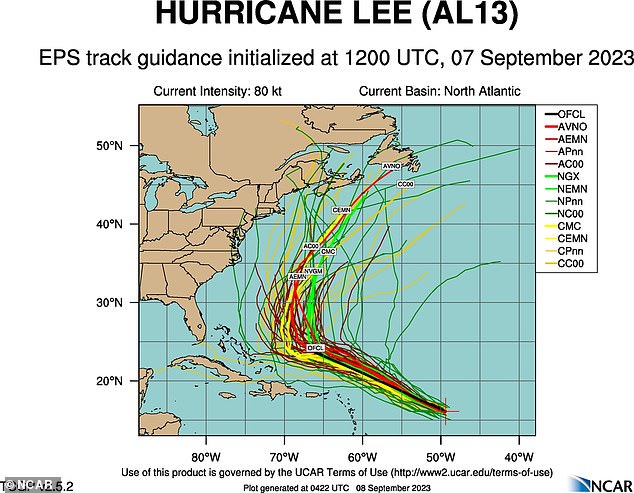
Forecasters have struggled to determine the exact path and strength of Hurricane Lee, leading to varying estimates about the extent of damage it could cause.
The National Hurricane Center said Friday that the storm was “incredibly powerful” and had escalated far beyond the strength it initially appeared to have.
While some areas in the storm’s potential path showed no signs of wet and wild weather – with Washington DC enjoying sweltering weather on Friday evening – the hurricane’s currents were cited as a cause of the storms that hit over the weekend.
More than 200 flights from JFK, Newark and LaGuardia airports have been canceled, according to the report Flight consciousFriday as thunderstorms rolled in.
As the thunderstorms hit, residents took to social media to share images of ominous clouds filling the New York sky as a sign of what’s to come.
Reports indicate that trees and power lines have been downed in New Jersey, and a severe thunderstorm warning has been issued for nearly the entire tri-state area until 11 p.m. Friday.
Flash flood warnings have also been issued for large parts of the Hudson Valley after a period of dry and hot conditions.
Much of Massachusetts also remains under severe thunderstorms, including Middlesex, Essex, Franklin, Hampden and Hampshire counties.
In Hoopsick Falls, New York, the town’s mayor urged residents to stay indoors as a powerful thunderstorm hit the community of 3,000 people on Thursday.
Downed trees and power lines were also reported in the area as crews worked throughout the day to clear roads after they were blocked by debris.
Storm damage was also observed in Boxborough, Massachusetts – about 40 miles from Boston – where several power lines and tree branches were snapped by the high winds.
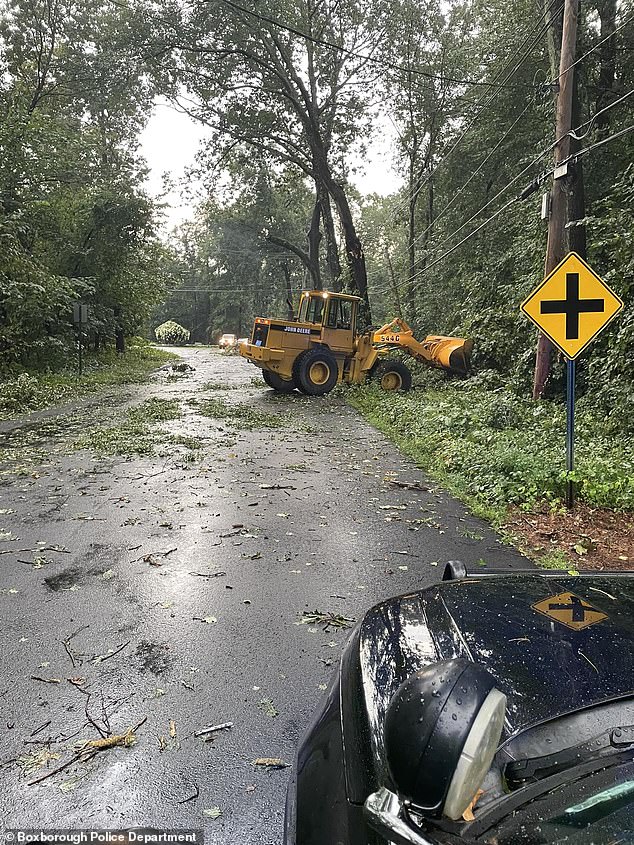
Storm damage was also seen in Boxborough, Massachusetts, where high winds snapped several tree limbs

Crews worked through Friday to clear roads after the storm surge ripped through, also downing power lines
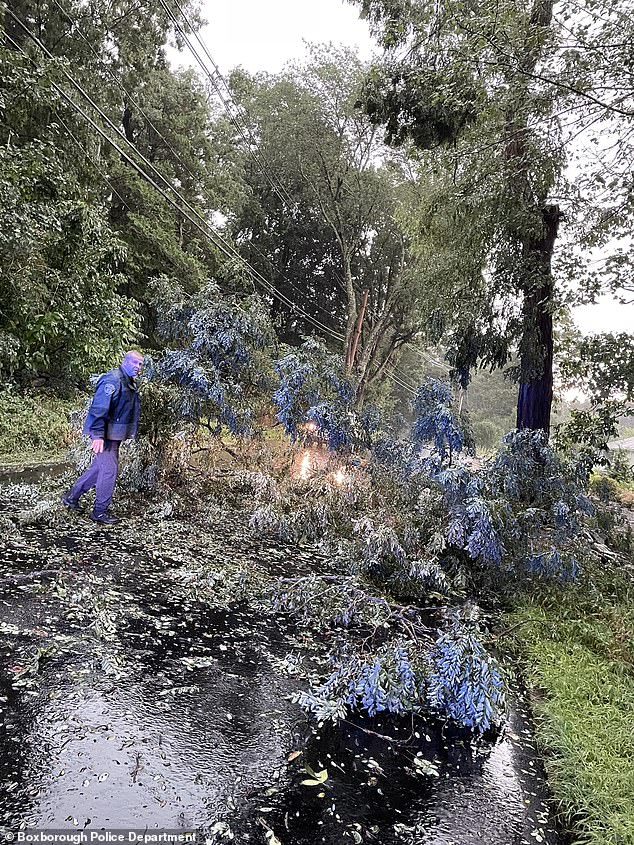
Another image of chaos caused by Friday’s extreme weather in Massachusetts
